By Sumaiya Farheen and Andrew Siyabalawatte, May 2023.
What is Ankylosing Spondylitis (AS)?
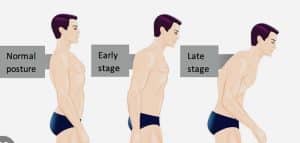
Ankylosing spondylitis (AS) is a long-term (chronic) condition in which the spine and other areas of the body become inflamed.
Risk Factors of AS?
HLA-B27 Gene
If you have a family history of ankylosing spondylitis, you are more likely to develop the disease. There is no definitive test to diagnose this condition, however a blood test or an X-Ray may be useful.
Age
Most people develop symptoms of ankylosing spondylitis before age 45. However, some people develop the disease when they are children or teens.
Other conditions
People who have Crohn’s disease, ulcerative colitis, or psoriasis may be more likely to develop the disease.
Symptoms
Symptoms may flare up (worsen) and improve (go into remission) off and on. Common symptoms include –
*Difficulty breathing.
*Fatigue.
*Loss of appetite and unexplained weight loss.
*Vision problems
*Lower back pain and stiffness.
*Hip pain.
*Joint pain.
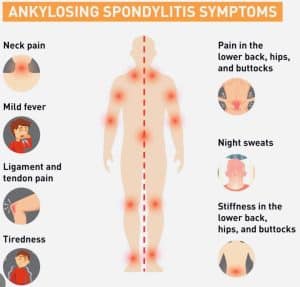
Long Term Complications of Ankylosing Spondylitis
As the condition develops, it may affect more than just the spine, it may inflame joints in the pelvis, shoulders, hips, knees, also between the spine and ribs.
Other complications include –
*Painful eye inflammation (iritis or uveitis) and sensitivity to light (photophobia).
*Fused vertebrae (ankylosis).
*Kyphosis (forward curvature of the spine).
*Osteoporosis.
*Cauda equina syndrome (nerve scarring and inflammation).
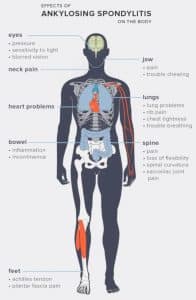
How is Ankylosing Spondylitis Treated on The NHS?
On the NHS, patients of AS are offered physiotherapy or medicine. Physiotherapy does not usually involve hands on treatment, It most likely involves advice about the most effective exercises for you to manage your condition.
Painkillers in the form of Non-steroidal anti-inflammatory drugs (NSAIDS) such as ibuprofen are usually recommended.
Here at Back To Health Wellness, we offer each individual with AS a tailored program to help manage their symptoms the most effective way.
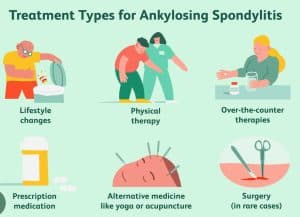
Our Top 6 Tips To Manage Ankylosing Spondylitis
We advise and teach you –
How to strengthen your back and neck muscles.
Ways to Improve core and abdominal muscle strength by seeing our Osteopath or Chiropractor.
How To Maintain and improve flexibility in joints.
Ways To Maintain a Healthy diet
How To Exercise
Exercise is important for maintaining healthy and strong muscles, preserving joint mobility, and maintaining flexibility. We advise on the best exercises for your condition.
Ways To Improve Your Posture
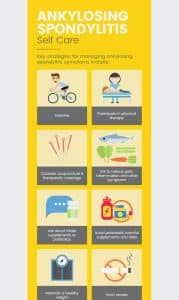
We teach you how to practice good posture. Our Chiropractor or Osteopath can give you tips and exercises which helps improving your posture.
The Best Pain Relief for Ankylosing Spondylitis
Deep Tissue Massage-This form of massage focuses on manipulating both the top layer and deeper layers of muscle and other tissues, especially those that are significantly affected by your condition.
Lymphatic Massage-Also known as lymphatic drainage massage or a detox massage, this form of massage uses light, patterned strokes to help excess lymphatic fluid drain into the bloodstream. This is particularly useful in treating areas of poor circulation due to the limited movement caused by Ankylosing Spondylitis.

Petrissage-If you opt for this massage technique, your therapist will gently lift your skin and knead or roll it. This can help lengthen the tissues that connect to your muscles, enabling them to relax a little. This type of treatment provides a therapeutic effect which significantly benefits tired muscles and tissues.
Book a massage session with us at our Guildford clinic.

